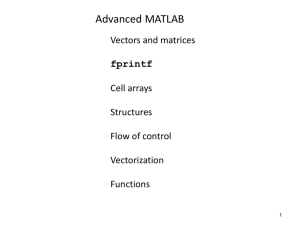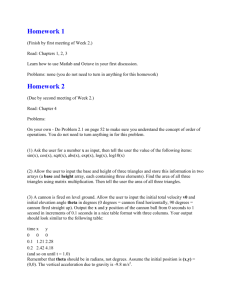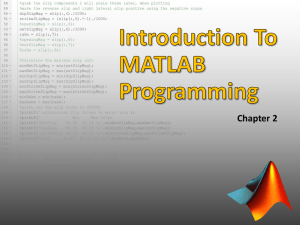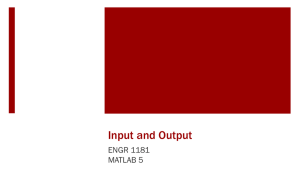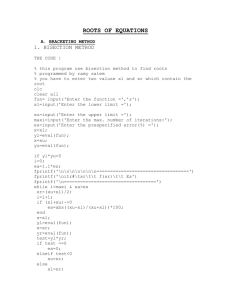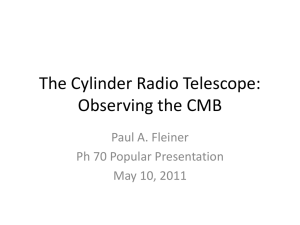Document
advertisement
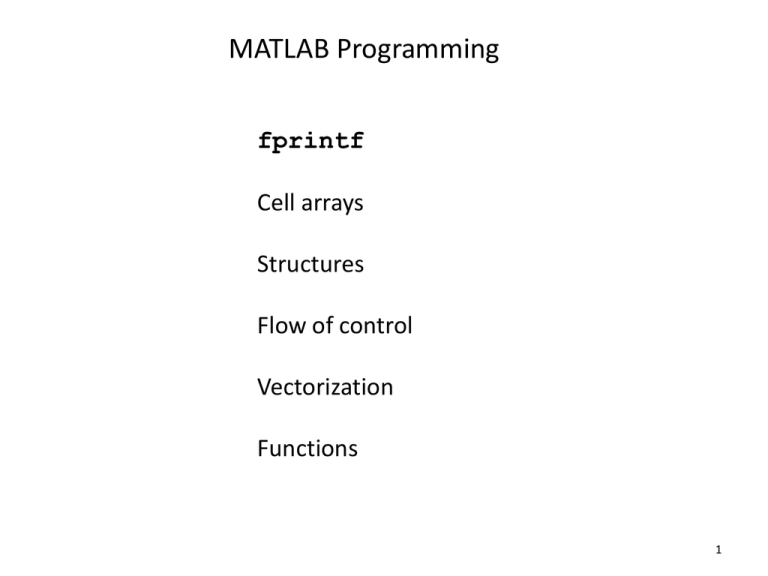
MATLAB Programming
fprintf
Cell arrays
Structures
Flow of control
Vectorization
Functions
1
MATLAB Documentation for fprintf
fprintf
Write data to text file
Syntax
fprintf(fileID,formatSpec,A1,...,An)
My comments:
fileID not used when printing to Command Window
formatSpec enclosed in single quote marks: ‘string’
A1,…,An are variables (or numbers) to be printed
2
% print pi to 7 decimal places
fprintf('%9.7f\n',pi)
% f
fixed-point number
% a.b
field width = a characters
%
b digits to the right of decimal point
% \n
newline
3.1415927
3
% print a column of numbers
x = [1.34, -2.45, 0.91];
fprintf('%5.2f\n',x) % There can be 2 characters on left.
1.34
-2.45
0.91
4
Exercise
Print 𝜋 as a fixed-point number to 12 decimal places.
5
% print signed integers with field width 4
x = [198, -230, 3];
fprintf('%4d\n',x)
198
-230
3
6
Exercise
Create a vector containing the (integer) elements: 0, -1, 2, -3.
Print these numbers in a column with right justification.
7
Cell Arrays
A cell array can combine different data having different data
types all in one array.
A cell within a cell array is referenced by an index.
A cell array is frequently an input argument of a function.
This permits a collection of data (even of different data
types) to be input to the function using a single argument.
8
% create a cell array using braces {}
y = {'scores',[73,38,81,55]};
y{3} = 'success';
celldisp(y)
y{1} =
scores
y{2} =
73
38
81
55
y{3} =
success
9
% What is in the second cell of the cell array y?
disp(y(2))
[1x4 double]
10
% What values are in the second cell of the cell array y?
disp(y{2})
73
38
81
55
11
% print values in the cell array y
fprintf('%s: ',y{1})
fprintf('%2d ',y{2})
fprintf('\n')
scores: 73 38 81 55
12
% create a cell array using the function cell()
x = cell(1,2);
x{1} = 'salary';
x{2} = 45000;
celldisp(x)
x{1} =
salary
x{2} =
45000
13
Exercise
1. Create a cell array that contains three cells:
A string containing your first name,
An unsigned integer (uint8) containing your age, and
A vector containing any two numbers between 0 and 1.
2. Use celldisp to display the contents of the cell array.
3. Extract the string in the first cell.
4. Extract your age.
5. Extract the first number in the vector.
14
Structures
A structure can combine different data having different data
types under one banner.
Each component of a structure is called a field.
A structure array is an array, each element of which is a
structure, and all structures in the structure array have the
same set of fields.
15
% simple structure
a.label = 'x';
a.vect = 0:5;
disp(a)
label: 'x'
vect: [0 1 2 3 4 5]
16
Exercise
1. Create a structure that contains two fields: a name (string)
and a number. Place any values you want into these fields.
2. Use disp to display the fields of this structure.
17
% create structure array using function struct()
c = struct('label',{'x','y'},'vect',{0:5,0:10});
disp(c)
disp(c(1))
disp(c(2))
1x2 struct array with fields:
label
vect
label: 'x'
vect: [0 1 2 3 4 5]
label: 'y'
vect: [0 1 2 3 4 5 6 7 8 9 10]
18
% create 1 x 2 structure array
c = struct('class',{71,72},'language',{'C','MATLAB'});
for n = 1:2
fprintf('ECE %2d: %s\n',c(n).class,c(n).language)
end
ECE 71: C
ECE 72: MATLAB
19
% structure array
b(1).label = 'x';
b(2).label = 'y';
b(1).vect = 0:5;
b(2).vect = 0:10;
disp(b)
disp(b(1))
disp(b(2))
1x2 struct array with fields:
label
vect
label: 'x'
vect: [0 1 2 3 4 5]
label: 'y'
vect: [0 1 2 3 4 5 6 7 8 9 10]
20
Exercise
1. Create a 1x2 structure array that contains two fields:
a string containing a first name, and
a number containing an age (in years)
Provide a value for each field of each structure in the
structure array.
2. Use a loop and the fprintf function to print the data in
the structure array.
21
Flow of Control
Redirection
if
else
elseif
Loops
for
22
Relational Operators
x == y equal to
x ~= y not equal to
x < y less than
x <= y less than or equal to
x > y greater than
x >= y greater than or equal to
23
Logical Operators
&&
||
(short-circuit) and
(short-circuit) or
24
% if
for k = 0:3
if k == 2
disp(k)
end
end
2
25
% if and else
for k = 0:3
if k >= 2
disp(k)
else
disp([num2str(k),' < 2'])
end
end
0 < 2
1 < 2
2
3
26
% elseif
for k = 0:3
if k < 2
disp([num2str(k),' < 2'])
elseif k == 2
disp(k)
else
disp([num2str(k),' > 2'])
end
end
0 < 2
1 < 2
2
3 > 2
27
% or
for k = 0:4
if k < 2 || k > 3
disp(k)
end
end
0
1
4
28
% and (input number is 3)
x = input('number: ');
if x >= 1 && x <= 5
disp('between 1 and 5')
end
between 1 and 5
29
Exercise
Create a script that does the following:
1. Get a number (x) from the user.
2. If x is less than or equal to 3, set y to 3.
3. If x is greater than or equal to 6, set y to 6.
4. Otherwise, set y to x.
5. Display y.
30
% Compare 2 methods of printing a vector
tic
for k = 0:9 % within this loop, k is a scalar
fprintf('%1d ',k)
end
fprintf('\n')
toc
tic
m = 0:9;
fprintf('%1d ',m) % This is preferred.
fprintf('\n')
toc
0 1 2 3
Elapsed
0 1 2 3
Elapsed
4 5 6 7
time is
4 5 6 7
time is
It is faster.
8 9
0.000264 seconds.
8 9
0.000077 seconds.
31
% Add all even integers 0 through 100
x = 0;
for m = 2:2:100 % even integers, 2 through 100
x = x + m;
end
fprintf('%4d\n',x)
2550
32
Exercise
Calculate the sum of all odd integers from 1 through 101.
33
Vectorization
Preallocation of memory
Vectorizing Loops
34
% Preallocation of memory
N = 1000000;
tic % frequent lengthening of x
x(1) = 1;
x(2) = 2;
for n = 3:N
x(n) = x(n-1)*x(n-2);
end
toc
tic % FASTER: preallocation of memory for x
y = ones(1,N);
y(2) = 2;
for n = 3:N
y(n) = y(n-1)*y(n-2);
end
toc
Elapsed time is 5.386562 seconds.
Elapsed time is 2.242842 seconds.
35
% Vectorizing a loop: linspace
tic % slow
phi = 0;
dphi = 2*pi/100;
g = zeros(1,1001);
for n = 1:1001
g(n) = sin(phi);
phi = phi + dphi;
end
toc
tic % fast
phi = linspace(0,20*pi,1001);
h = sin(phi);
toc
Elapsed time is 0.002522 seconds.
Elapsed time is 0.000136 seconds.
36
Exercise
Here is one way to generate samples of a sinewave:
for n = 1:8
x(n) = sin(pi*(n-1)/4);
end
Enter the above code and display the results. Then vectorize this
code and verify that your vectorized code gives the same results.
37
Functions
Function m-file
Local variables
Functions with multiple inputs/outputs
38
function v = sphereVol(r)
% calculates the volume of a sphere
% input r = radius
% output v = volume
c = 4/3;
v = c*pi*(r^3);
end % sphereVol
39
Local Variables
Variables appearing in a function are local. These local variables do
not appear in the MATLAB workspace and are not visible outside of
the function in which they occur. For example, a variable c in the
MATLAB workspace will be unaffected by a (local) variable c that
appears within a function. Within the function, the local c is
recognized and the workspace c is not. When the function returns,
the local c is forgotten and the workspace c is again recognized.
The input arguments of a function have local names. When the
function returns, these local names are forgotten.
The output variables of a function have local names. The values of
these output variables are returned to the caller; however, the local
names of these output variables are forgotten.
40
% Script that calls the function sphereVol
c = 2;
radius = 1;
vol = sphereVol(radius);
fprintf('c = %3.1f, vol = %5.2f\n',c,vol)
whos
c = 2.0, vol = 4.19
Name
Size
c
radius
vol
1x1
1x1
1x1
Bytes
8
8
8
Class
Attributes
double
double
double
41
Exercise
1. Create a function m-file that computes the surface area of a
sphere. There will be one input, the radius, and one output,
the surface area.
𝐴 = 4𝜋𝑟 2
2. Create a script m-file that calls your function m-file.
42
function [radius, angle] = rect2polar(x, y)
% converts the (x,y) coordinates to polar coordinates
% inputs: rectangular coordinates x and y
% outputs:
% radius = distance from origin
% angle = angle (rad) measured counterclockwise from x axis
radius = sqrt(x.^2 + y.^2);
angle = atan2(y,x);
end % rect2polar
43
% Rectangular to polar coordinate conversions
x = linspace(1,0,5);
y = linspace(0,1,5);
[r,theta] = rect2polar(x,y);
table = [x; y; r; theta];
fprintf('
x
y
r
fprintf('%5.2f %5.2f %5.3f
x
1.00
0.75
0.50
0.25
0.00
y
0.00
0.25
0.50
0.75
1.00
r
1.000
0.791
0.707
0.791
1.000
theta\n')
%5.3f\n',table)
theta
0.000
0.322
0.785
1.249
1.571
44
Exercise
1. Create a function m-file that takes two inputs and produces two
outputs, where the inputs are the polar coordinates (𝑟 and 𝜃)
of a point in 2-dimensional space and the outputs are the
rectangular coordinates (𝑥 and 𝑦).
𝑥 = 𝑟 ∙ cos(𝜃)
𝑦 = 𝑟 ∙ sin(𝜃)
2. Make sure to include some comment lines, including an H1 line.
3. Create a script m-file that calls your function m-file.
45

